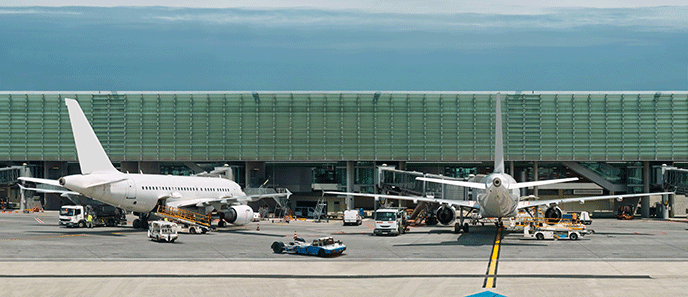Airports are akin to mini cities with a plethora of stake holders and business activities both related to aviation in all its shapes and forms as well as Non-Aviation – “service providers”
An Airport Master Plan is an integral component of the strategic decision making process to take into account both Short Term and Long Term Policy objectives. It is of primary importance that anyone who is tasked with developing an Airport Plan engages with all stakeholders to ensure appropriate consultation and coordination takes place throughout the development and implementation process.
It is reasonable to offer that the most effective Airport Master Plans offer a scalable environment built around an efficient framework which delivers the required capacity to accommodate Aircraft, Passengers, Cargo and ground movement of vehicles airside. As well as landside management of Passengers, Vehicles, Transport infrastructure all delivered at the lowest possible capital expenditure with the optimum return on investment.
Overall Objective
To develop an airport plan which supports a layout designed to yield the optimum airport capacity consistent with the available land. To ensure the capability to meet future demand as well as meeting the obligation to comply with all international operating standards.
General Issues to consider include
a) The development of the physical components both related to Aviation and Non Aviation Elements
b) Optimising land use in the vicinity of the Airport
c) Considering the environmental impact both during the constructional phase and in anticipation of the post implementation operational phase
d) Considerations related to the vehicular and other transport system access requirements
e) Entering into dialogue negotiations and expressions of interest related to the business community
f) Considering the specific requirement of the aerodrome authority.
g) Considering the specific requirements of the government control authorities (immigration, customs, health)
h) National and local government planners
I) Analysing airfield configuration options (including approach zones)
h) Reviewing the opportunities for funding and aid.
To consider the advantage of developing a broad spectrum integrated plan involving preparation and consolidation of specific policies, plans and programs.
Potential consultation and coordination committees either separate or integrated involving:
Operator (Passenger, Cargo & Business)
Government Planners both at National and Local Level
Transport Authorities both at National and Local Level
Aircraft Support and Ground Handling / Ground Servicing equipment manufacturers
International Aviation Agencies – Other related International business partners
Airport Business Stakeholders and potential / Existing Concessionaires
Local business and Residential Communities
Overarching Planning Goals
a) Orderly timeline to manage the progressive development of the airport to meet the present and future needs of air transportation.
b) Review and Coordinate local, regional and national plans
c) Ensure Protection of the Environment in respect of noise & pollution
d) Development of the Terminal complex
e) Selection Development and commissioning of the Circulation, utility and communications networks
Project Implementation Management and Oversight
a) Establish effective airport administration organisation for project implementation
b) Define project goals, objectives & develop implementation programmes, schedules and
Budgets, Coordination and monitoring procedures, data management and public information system.
c) Ensure compatibility with state/country aviation regulatory and national requirements
d) Ensure compliance with ICAO and IATA standards
e) Coordinate National and Regional Airport Communication and Control Systems
f) Coordinate plans for Navigation Facilities, together with airspace and air traffic control procedures
g) Optimize use of land and airspace resources
Economic Planning Considerations
a) Prepare analysis of aviation market trends together with short, medium and long term trends to focus on the potential for aviation activity
b) Analyse the potential benefits and costs related to any alternative solutions, including impact assessment of alternatives.
c) Develop the Physical Planning Elements required for airspace and air traffic control provisions.
d) Review the requirement for support and service facilities including all ground access systems
Environmental Planning Considerations
a) Prepare an impact assessment of natural environmental conditions, related to the following – plant life, animal life, climate, natural resources and topography
b) Document potential future development plans consider local and regional attitudes and opinions
Financial Planning Considerations
a) Determine airport funding source and constraints
b) Prepare a financial feasibility study of various airport development alternatives
c) Prepare preliminary financial plans and implementation programmes for final selection
Ongoing Review
a) Annually and adjust plans according to changes and other economic constraints
b) Perform in depth and intensive analysis at periods of 5 years or more frequent if circumstances dictate
Implementation Considerations
a) Prepare development program and identify responsibilities
b) Perform Inventory and document existing conditions
c) Forecast future air traffic demand
d) Determine facility requirements and staged development
e) Final evaluation of existing and potential constraints – operational, financial and environmental impact
f) Select most acceptable and appropriate alternatives, modify id appropriate and finalize
Note concerning additional factors that will affect capacity
The following may have a direct bearing and create capacity constraints:
a) Airfield configuration (runway, taxiway, gates & other parking positions
b) Operating environment
c) Navaids and ATC facilities
d) Airspace, arrival and departure routes
e) Extent of ATC facilities approach/departure control tower
Sofema Aviation Services www.sassofia.com offers EASA Compliant Airports Regulatory Training.
Please see website or email office@sassofia.com




